Building and Landscaping
- Animals, Bees, Birding, Building and Landscaping, Chickens, Compost, Fungus and Mushrooms, Gardening adventures, Hugelkultur, Microbes and Fungi, Natives, Natural cleaners, Other Insects, Permaculture and Edible Forest Gardening Adventures, Pets, Ponds, Predators, Quail, Rain Catching, Reptiles and Amphibians, Water Saving, Worms
Saving the Bees

The ponds at Finch Frolic Garden are cleaned by fish and plants, with no chemicals, algaecide, artificial aeration or filtration. Well-balanced water allows wildlife to thrive. I should have more accurately called this post, Saving All the Insects, or even Saving the Wildlife, because the answer to saving one is the answer to saving them all. We’ve been inundated for years – my whole lifetime, in fact, – with pleas to save our environment, stop whale slaughter, stop polluting, etc. I remember winning a poster contest in fifth grade on the subject of curtailing littering. Since Rachel Carson’s books woke people up to the hazards of DDT and how chemicals have many deadly side effects there has been a grassroots effort to stop the pollution. Since Al Gore’s An Inconvenient Truth came out the push for environmentally friendly lights, cars, LEED-certified buildings and many more positive anti-climate-change actions have grown furiously. Too bad no one listened to him decades before. A drop in the economy and the radical change in weather patterns have people exploring organics, making their own clothes and foods, changing their shopping habits and thinking about what they are bringing into their homes. However, this week the World Wildlife Fund released the staggering results of a study that states that between the years 1970 and 2010, 52% of the world’s animal populations are gone. Over half. Gone. On our watch. In my lifetime. I am stunned with shame. So what about the next 40 years? Over 97% of California wetlands are already gone. There are only 3% left in Los Angeles. The Colorado River hasn’t met the ocean for decades, except briefly last year due to major earthworks. We are pumping all that water overland, open to the sun for evaporation, to treatment plants that fill it with chlorine and other chemicals, then sell it to us to spray over lawns and flush down the toilet or let run down the drain while the water heats up. It is madness. All the wildlife that depended upon the Colorado River along that stretch are gone. All the insects, the frogs, lizards, birds, mammals, etc. that need a clean drink of water no longer have access to it. The only water they can drink is usually chlorinated domestic water in ponds and bird baths. Too often this water is treated with algaecide, which claims it doesn’t hurt frogs but it does kill what the frogs feed upon. We are killing our animals with poisoned domestic water.
![dry_colorado_new[1]](http://www.vegetariat.com/wp-content/uploads/2014/10/dry_colorado_new1-613x321.jpg)
One of the largest reasons we have extinctions in North America is mismanagement of rainwater in drylands (other than polluting the waters. Poaching, over-fishing, destruction of habitat and climate change are the main reasons). We have cleared and flattened the ground, and channel rainwater off into the ocean. Look around at your streets and houses. Are they harvesting water or channeling it? Any property that is slanted is channeling water away. Any property that is level – like the bottom of swales – is harvesting water. So many properties are inundated with annual rains because there is no water harvesting above them. When you harvest water, it runs into rain catchment basins and swales instead of roaring down the hillside taking all the topsoil with it. Water becomes passive and percolates down deeply into the soil. That deep saturation draws tree roots down into the ground. The roots break up hardpan, make oxygen and nutrient channels into the dirt and produce exudates (sugars, carbohydrates and starches) through their roots to attract and feed the billions of microbes that turn your dirt into rain-holding soil. That underground plume of rainwater then slowly passes through your soil, re-enervating subterranean waterways, refilling your wells and bringing long-dry streambeds back to life. We must harvest rainwater to save our animals and plants, and consequently ourselves. We must reestablish sources of clean, unpolluted chemical-free water for animals to eat and from which to drink.
Healthy pond water is off-color due to tannins, and is filled with tiny creatures. Some such as daphnia are visible, but just like soil microbes, many aquatic creatures are microscopic. Fish and frogs feast from this level of the food chain, and these creatures make the water balanced. They eat mosquito eggs. They clean up algae. They are as vitally important as soil microbes. Oh, and 83% of the frogs are gone.
I spoke with Quentin Alexander from HiveSavers today; he performs humane bee rescue around the San Diego area and has been trying to re-queen Africanized hives with calmer European queens which will breed nicer behavior back into the bees rather than having to kill the entire hive. He has had no luck in the past two years with European queens, even those bred in California. With very little wetlands left, and those often sprayed with DEET by Vector Control, or polluted with chemical fertilizers and oils washed out of front yards, streets and driveways, these insects must resort to drinking from swimming pools and bird baths. Again, these contain highly chlorinated water. Animals are being forced to drink poison, or not drink at all.
We MUST stop using chemicals on our properties, and we MUST harvest rainwater. We MUST stop spraying well water into the air but irrigate with it in dripper form under mulch so that it is cycled back into the ground rather than evaporated. One inch of rain on one acre in one hour is 27,154 gallons of water! It is so easy to harvest rainwater – dig level-bottomed swales! Dig small ones with a trowel. Fire up the tractor and turn road ways into swales, or cross-cut vertical paths with swales that have dedicated overflows. Dig rain catchment basins to catch a flow of water. Catch water as high up on your property as you can. If you have level soil, fantastic! You have it so easy!
Make gentle swales, rain gardens, rain catchment areas and sunken gardens to catch and percolate the water. Bury old wood perpendicular to water flow – its called hugelkultur.
Please watch this six-minute video by Geoff Lawton of the Permaculture Design Institute of Australia. You need to type in your name and email, but they don’t sell your information nor do they bug you with lots of emails. Here is the link. The title is Finding An Oasis in the American Desert, and it is about the Roosevelt swales dug during the dust bowl in the desert. If nothing that I say, nor anyone else says can convince you, then please watch this and see the effectiveness of rain harvesting. We MUST do this, and now before the rains come is the time. Catch all the water that falls on your property in the soil, and try to catch the water that runs into it. If there are flood waters channeled through your property, see if you can talk to the people who own land above you about harvesting water up there. It will reduce the flooding, save topsoil and benefit everyone’s property. Work towards keeping rainwater in your soil, reducing your domestic water, and making what streambeds are left come back to life. Keep our old trees from dying by watering deeply through rain catchment. If you have a pond or swimming pool and treat it with harsh chemicals and algaecides, seek out a natural pond professional. In the San Diego – Los Angeles region there is Bob Lloyd of PuraVida Aquatics, or Jacob Hatch of Hatch Aquatics. Jacob builds natural ponds and maintains large natural waterways. Bob maintains chemical-free backyard and display ponds that are full of wildlife. He can convert your pool into a clean swimming pond where the water is filtered by plants and thus is lovely year-round, provides abundant habitat and doesn’t need chemical treatments. No chlorine to burn your skin and eyes. How great is that? He can also create a constructed wetland that cleans your greywater with plants.
There are so many simple and inexpensive ways to harvest rainwater rather than allow it to flow into the salty ocean without penetrating the soil. Please, please, please do them, and if you already have THANK YOU and gently encourage your neighbors to do the same. We must stop the habitat destruction and start to rebuild what is gone.
- Animals, Bees, Birding, Building and Landscaping, Chickens, Cob, Compost, Composting toilet, Fungus and Mushrooms, Gardening adventures, Giving, Health, Heirloom Plants, Hiking, Houses, Hugelkultur, Humor, Living structures, Natives, Natural cleaners, Other Insects, Permaculture and Edible Forest Gardening Adventures, Pets, Photos, Predators, Quail, Rain Catching, Recycling and Repurposing, Reptiles and Amphibians, Seeds, Soil, Vegetables, Water Saving, Worms
Special Tours for Aug. and Sept., 2014
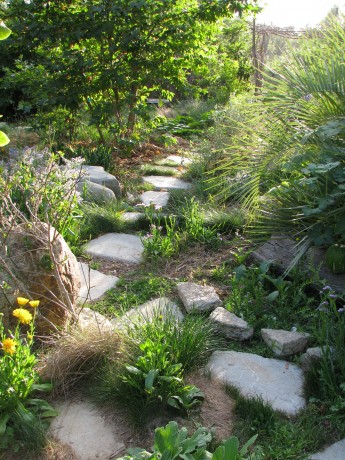
Come take a tour of a food forest! Normally tours of Finch Frolic Garden are held by appointment for groups of 5 – 15 people, Thursdays – Mondays. Cost is $10 per person and the tour lasts about two hours. By popular demand, for those who don’t have a group of five or more, we will be hosting Open Tour days for the first 15 people to sign up in August and September. They will be Sunday, August 10 and 24, Sept. 7 and 21, and Thursdays August 7 and 28, and Sept. 11 and 25. Tours begin promptly at 10 am. The tours last about two hours and are classes on basic permaculture while we tour the food forest. I ask $10 per person. Please reserve and receive directions through dianeckennedy@prodigy.net. Children under 10 are free; please, no pets. Photos but no video are allowed. Thank you for coming to visit! Diane and Miranda
- Animals, Bees, Birding, Books, Building and Landscaping, Chickens, Cob, Compost, Composting toilet, Fungus and Mushrooms, Gardening adventures, Heirloom Plants, Hugelkultur, Humor, Living structures, Natives, Natural cleaners, Other Insects, Permaculture and Edible Forest Gardening Adventures, Ponds, Predators, Quail, Rain Catching, Recycling and Repurposing, Reptiles and Amphibians, Seeds, Soil, Water Saving, Worms
Permaculture Lectures At Finch Frolic Garden, June 2014
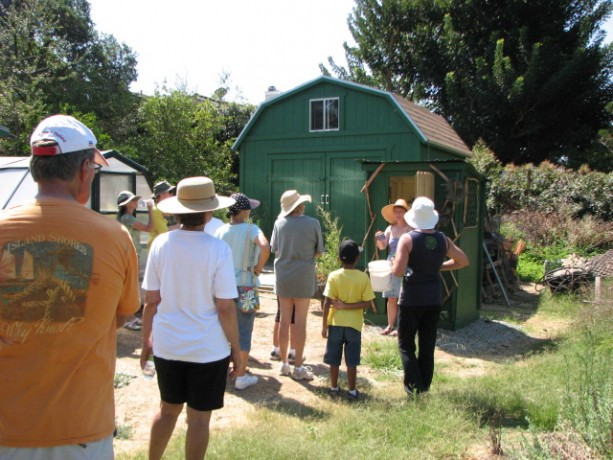
Tour Finch Frolic Garden! Permaculture Lectures in the Garden!
Learn how to work with nature and save money too
Finch Frolic Garden and Hatch Aquatics will present four fantastic, information-filled lectures in June. Join us at beautiful Finch Frolic Garden in Fallbrook, 4 pm to 6 pm, for refreshments and talks on…
Saturday, June 7: Introduction to Permaculture and Finch Frolic Tour: We’ll take you through the main precepts of permaculture and how it can be applied not only to your garden, but to yourself and your community. Then we’ll tour Finch Frolic Garden and show rain catchments, swales, plant guilds, polyculture, living buildings and so much more.
Saturday, June 14: Your Workers in the Soil and Earthworks: Learn the best methods for storing water in the soil and how to replace all your chemicals with actively aerated compost tea and compost.
Saturday, June 21: Aquaculture: You can have a natural pond – even in a tub! How natural ponds work, which plants clean water and which are good to eat. Even if you don’t want a pond, you’ll learn exciting information about bioremediation and riparian habitat.
Saturday, June 28: Wildlife in your Garden: What are all those bugs and critters and what they are doing in your yard? We’ll discuss how to live with wildlife and the best ways to attract beneficial species.
Your hosts and lecturers will be
Jacob Hatch Owner of Hatch Aquatics. With years of installing and maintaining natural ponds and waterways, and a Permaculture Design Course graduate, Jacob has installed earthworks with some of the biggest names in permaculture.
Miranda Kennedy OSU graduate of Wildlife Conservation and wildlife consultant, Miranda photographs and identifies flora and fauna and maps their roles in backyard ecosystems.
Diane Kennedy Owner of Finch Frolic Garden, lecturer, consultant, Permaculture Design Course graduate, former SDC Senior Park Ranger, Diane educates homeowners on how to save money and the environment while building their dream gardens.
Each class limit is 50 attendees, so please make pre-paid reservations soon before they fill up. Fee for set of four lectures and tour is $45 per person. Single session fee is $20 per person. Contact Diane Kennedy at dianeckennedy@prodigy.net for reservations and directions.
You will not want to miss this fascinating and useful information!
- Building and Landscaping, Compost, Fungus and Mushrooms, Gardening adventures, Heirloom Plants, Hugelkultur, Natives, Permaculture and Edible Forest Gardening Adventures, Rain Catching, Seeds, Soil, Water Saving
The Albedo Effect: How Bare Earth Causes Wild Weather
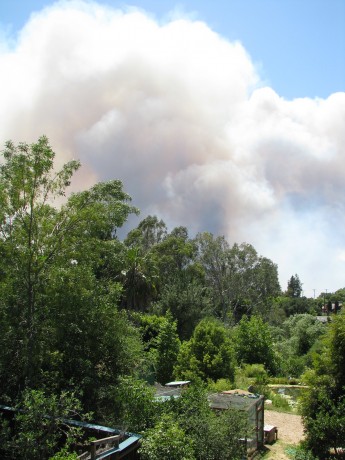
This week’s 100F+ temperatures and high Santa Ana winds have fueled three fires close to us. It is May, not October. Albedo is a reflection coefficient. In layman’s terms it is the effect that happens when sunlight is reflected off of white areas. There is the high albedo of bare earth, snow and ice, and clouds, and the low albedo of water and vegetation. There is less reflection from dark areas such as off of water and green areas, and darker areas, just like dark clothing, absorbs more heat rather than reflects it like white clothing does. There are arguments that we should cut down all the trees to increase white space to stop global warming. NO! The plant life that occupies the green spaces transpire water and excess heat into the air, causing cloud cover. Clouds, of course, insulate the earth from the sun and their albedo effect is cooling to the earth, not to mention that clouds amass moisture and – bingo – you get rain. It is the loss of green areas and the desertification of large masses of Africa, and the in-progress desertification of the already drier areas of the world (such as California) that makes the albedo effect one that is helping warm our climate. Great tracks of land now reflect light into cloudless skies; water sources dry up and plants die so transpiration disappears. The loss of air-borne water (evapotranspiration) allows areas around the desert area to also dry out. The rapid change of climate due to desertification, loss of topsoil and the resulting erosion and the melting of our ice caps (creating larger oceans and thus larger thermal masses to reflect heat) causes severe weather patterns – weather patterns that balance out huge dry desert areas with destructive rain and wind storms in other areas. Drying areas ignite… here in San Diego North County there are five fires burning as I sit, and heavy smoke and ash rain down on everything between them. My house is not threatened at this time, but we may be evacuated. So many people are evacuated right now and the highways are packed. There is another fire near San Diego, and two between here and Los Angeles. It is May – usually we have these temperatures, wild winds from the desert called Santa Ana winds, and fire threat in October. Our lack of rain doesn’t bode well for California.
My point is that to help balance nature out again, we need to hurriedly lessen the amount of reflected light in areas where we were traditionally covered by plants. We need to plant. We need to plant native plants. We need to re-green our landscapes, in each backyard and vacant lot, as quickly as we can. Allow the plants to keep moisture in the soil, to slow flooding, to transpire moisture into our atmosphere so that rain comes back to the desert areas. We need to hold what rain that falls in our soil by burying wood (hugelkultur), by creating level swales and mulching, mulching, mulching. Yet on trash day I see bags and bags of leaves set on the street ready to go to the dump. We need to stop erosion areas by using whatever means we can to keep the topsoil back. We need native trees with long roots that will hold the soil, build topsoil and transpirate.
Of course you probably can’t afford lots of plants, so plant natives that will quickly grow large. Between the slower-growing oaks, plant sages, mallows, ceanothus, quail bush and other bushes that cover 10 -15 feet of dry earth. Under them will be moisture, protected soil with mulch from their leaves, and habitat for lizards, frogs, small birds and hundreds of insects. These bushes will help shade young oaks, sycamores, and other trees and keep their trunks from scorching.
Throw down seeds of California fescue (Festuca californica var. parishii) to hold soil and cover the dry, reflective areas. This native grass is tough and doesn’t cause trouble like non-native grasses. You can seed it with California poppies, lupine and other native flowers. Aggressively weed out non-native species.
Since I was little, in the 60’s, I heard the mantra ‘plant a tree’. Obviously we haven’t been doing that. I think it should be changed to ‘plant a tree and don’t cut down any more because the earth can’t afford it’!
Please plant! And all my hope goes to you and yours who are threatened or have had losses from our severe weather.
- Arts and Crafts, Building and Landscaping, Gardening adventures, Permaculture and Edible Forest Gardening Adventures, Recycling and Repurposing
Urbanite, the New Name for Chunks of Cement

Urbanite stepping stones work beautifully in the garden allowing plants to grow in between. Just as old LPs or records are now called vinyls, so are chunks of a neighbor’s patio called urbanite. I like the term because it makes the mental transition from a waste product – cement chunks – to building material. Put an ‘ite’ at the end, and you can use it. The name urbanite also makes me envision pieces of nature-less cities being used for more natural landscapes. There are spaces around chunks of cement for plants to grow.
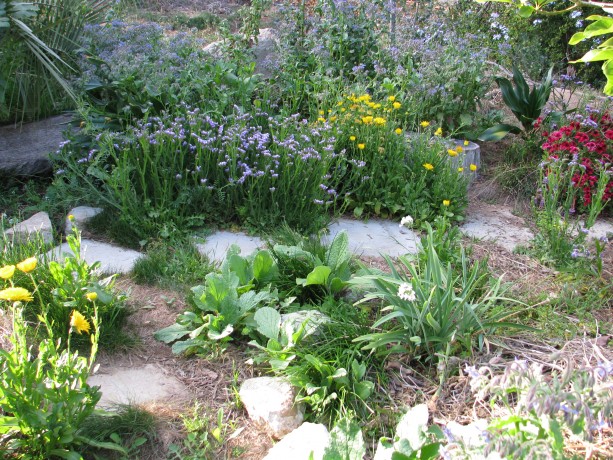
Urbanite lasts a long time, too, and it is free. The idea of working with cement chunks doesn’t sound aesthetically pleasing, but done well it always has visitors to Finch Frolic Garden enthusiastic. A pathway and two retaining walls were made of urbanite, and they are all wonderful.
A friend and former co-worker called me a few weeks ago to offer urbanite from a piece of her patio that had to be repoured. It took awhile but I found some help to go pick it up. With a small pickup truck we managed two loads; the pieces were stacked on the patio, but the only way to access them was to drive the pickup below the patio wall. Unfortunately, the ground was at an unnerving angle, and quite sandy so there was little traction. I handed pieces of urbanite over the wall and down to Jacob, who loaded them into the tilted truck. It was quite warm that day so we were well cooked. There was a lot left.
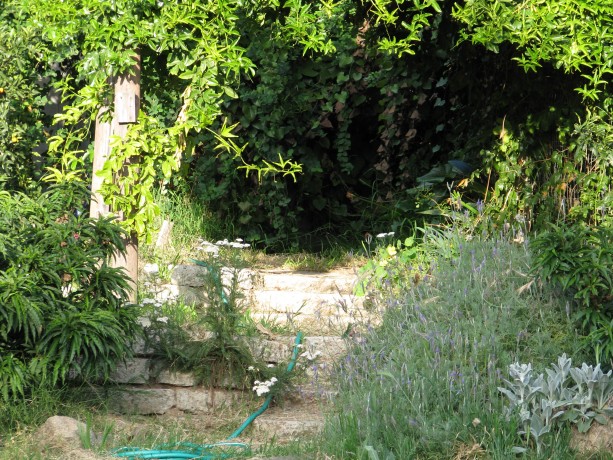
You can see the retaining wall and stairs made from urbanite peeking out from under the plants. Then Jacob arranged for me to borrow an old 2-ton pickup with 4-wheel drive. My daughter and I headed over two days ago during a cloudy morning intending to get the truck very close to the wall. No way. The truck tilted dangerously and began to slide, so I had to park it out on the driveway. Of course the sun came out. We spent three hours taking turns tossing huge chunks of cement over the patio wall, shot-putting the pieces so that they wouldn’t hurt the plants at the base of the wall, and then picking them up (finding some of them that had rolled downhill) and carrying them across the shifty dirt to hoist the pieces up and into the bed of the large truck. We swept rubble into nursery containers and dumped them into the truck as well.
Well cooked and completely exhausted, we made it home with the whole load, the truck tires just a little squished. Now we have urbanite to replace some of the stairs made from palms that are beginning to soften or which have been eaten by bunnies.
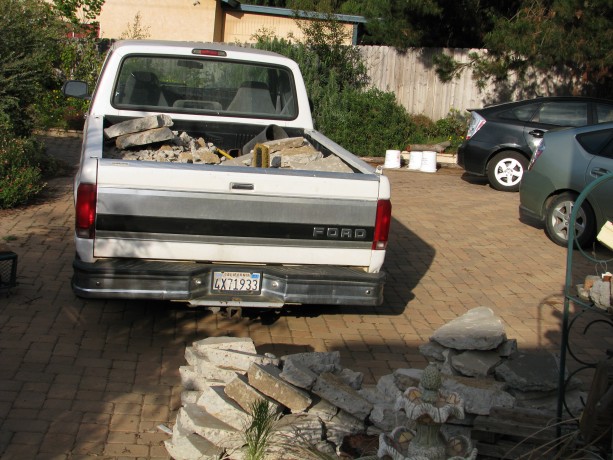
Ugh! Unfortunately, we still have to unload the truck.
